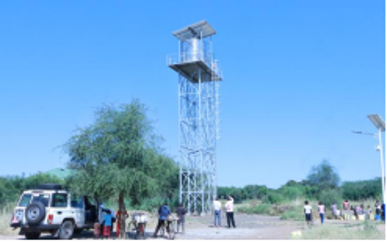Written by: Ballam Oyugi, WASH Supervisor for Uganda Red Cross Society | Jan 31, 2024
Uganda Red Cross Society (URCS) Moroto branch implemented the Skybird Micro Project themed around water supply, hygiene and sanitation promotion where the key activities were: motorization to solar power of a broken-down hand pump and connection to water points, construction of a public latrine, sanitation promotion and supporting households to use Circular Lined pits using granary technology to reinforce walls from collapsing due to the weak soil in the area (building Circular Pit Granary Technology-CPGT).
This blog is from the Skybird WASH Network webinar presentation by Ballam Oyugi, WASH Supervisor for Uganda Red Cross Society, about a solar powered water pumping system and their experiences in converting a broken-down hand pump to solar powered water pump system from design to implementation phase, adding the challenges and lessons learnt from the process.
Overview of Moroto branch:
Moroto is located in the eastern part of Uganda in Karamoja sub region. The climatic condition of the area is single rains season in a year for 3 to 4 months with the rest of the months being dry season. It is a highly water stressed with dispersed population. It is only in the project area that is a little denser population. The community within Karamoja sub region are majorly pastoralists looking after their animals, with some few populations in urban areas in other forms of livelihood activities.
Overview of Solar Pumping:
A solar pumping system for drinking water supply is composed of PV modules, controller, pump, water source, storage tank and tap stand. The solar-powered water pump system constructed in Matany town comprises 16,000Lts storage tank and 4 tap stands serving over 600 households living in 4 villages. The storage tank and solar panels are installed on a 12m high tower distributing water to four tap stands.
Required Data for System Design:
When designing solar powered schemes, the design should always be carried out through a reputable digital software design package such as Lorenzt, Grundfos, Wellpumps, etc. as the water output in solar powered schemes vary with time of day and season, making size optimization process using manual calculations complicated and imprecise.
Limiting the design period between 5 to 10 years has advantages because some components of the system such as the solar pump and inverter have a life time that do not accede 10 years, although Solar PV’s have a lifespan up to 25 years. It will also minimize the demand estimation error when taking shorter design period.
When carrying out the design there are specific information that is required by the software for system design. These include:
- Location GPS coordinate of the project area which is important for example in determining the solar irradiation for the site.
- Maximum daily demand in m3/day – unlike an hourly water demand that is used when designing water supply system powered by diesel generator or a hand pump, daily drinking water demand is used when designing solar powered water pumping system. This is because in solar powered system, different hours provide different outputs depending on the solar irradiation.
- Safe yield of water source in m3/hr is another important parameter. Even if the community drinking water demand is higher, it is restricted by the safe yield of the water source.
Other inputs such as the static & dynamic water levels, depth of pump installation, distance from water source to the tank, distance from the water source to the solar modules, the solar modules area, type of pipe from the source to the storage tank (metallic or plastic), total head of the system and other data are also required.
Steps in the construction of the solarized water scheme
The first step should be identifying the water demand and assessment inclusive of Environmental and Social Impact Assessment (ESIA), assessing issues related to how the land for the project is acquired with no farmers becoming marginal, also checking there are no ecological/biodiversity related concern or a forest area, to make sure the project has no significant impact on ecology of the area.
If the water source, in this case the borehole, data is not available, assessment need to be carried out on the borehole that is pumping test and chemical test. That is both the quantity and quality of the water need to be assessed.
Next step is analyzing the assessment results to offer a solution based on available fund. Sometimes the water source is too big, but the funding is not enough to install solar pumping that can serve the biggest population in need.
System design should then be conducted based on the actual field data obtained from the assessment report.
A tender document need to be prepared with agreements, drawings, bill of quantities and specifications, that are used during construction by the contractor or the service provider to construct the system.
The next step is to select a contractor who would carry out the construction of the system. After that a supervision of the construction should be carried out. It is important there is competent personnel to do the supervision that ensures value for money.
After completing the construction testing running of the system needs to be carried out to allow appropriate period of time for the contractor to correct all the system errors due to construction.
A defect liability period is also needed so that incase major defect arise within a period of for example three months then it will still be the liability to the contractor to come and correct all these defects that shall arise after completion of the construction.
Then finally the scheme is ready to be handed over to the local water authority for continuity in O&M.
Challenges Associated with Solar Pumping
Every system has challenges however good it might be. Some of the challenges in implementing solar pumping systems include:
- High capital cost that is the initial cost for installation of the system compared to other systems.
- Not having enough experienced personnel who can accurately design solar systems.
- There is also high risk of theft and vandalism especially to solar modules, because it is something that people need in their village as national grid power coverage in Uganda is very low.
- We also have few skilled technicians who can do the installation and maintenance of the system.
- The spares are not easily available within the community in case of any breakdown or any failure in the system. You only get the spares in cities.
- The other challenge is that it has limited hours of service since it depends on sun shine. The situation can arise that the demand is high and the water resource is available but you cannot pump beyond maybe specific period of hours within the day.
- At the implementation level, some contractors or service providers lack technical competency carrying our solarized systems or projects.
- Sometimes the system fails to function and water won’t reach to tap stands due to design or construction error. Because the moment you have errors in the design, they will do the construction right but it will not work, and sometimes the design is right but they do the construction in wrong way and the system will not work.
- If there is poor or non technical investigation, especially to the base of the water tank tower, the quantity of water that need to be stored is too heavy for the loose soil to carry it, leading to collapse of the tower.
Experience from the field (Assessments & Remedial Actions)
The borehole solarization water pumping system in Matany Town Council encountered technical issues after the construction due to less supervision and lack of technical expertise. The pictures from the field are to show the assessments which was done and then the remedial action that came after in the first place

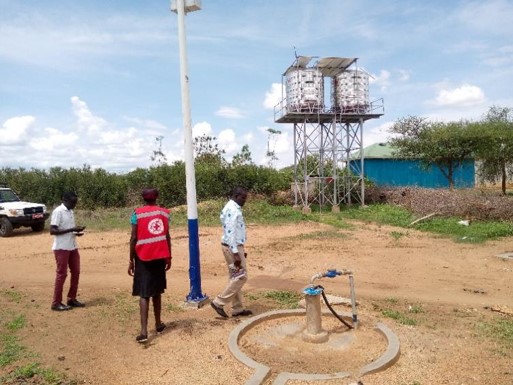
One issue was the storage tank was sitting in a loose foundation, as seen in picture below. Geotechnical assessment was not carried out at the start. There was no clear information of the nature of the soil. The nature of the soil was not examined.

As shown in pictures below, the structure is dismantled, the entire structure lifted and installed on a new footing.
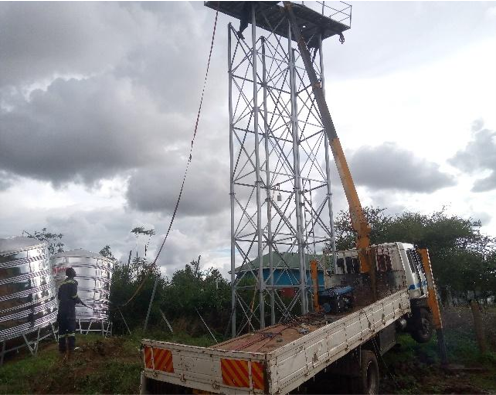
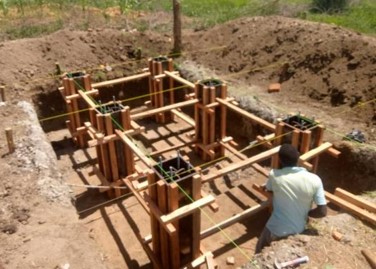
The other issue was water was not reaching at tap stands and the community after the system is installed. Outcome from the design software, the right size of pump, the right size of water storage tank and the right size of power cable was used but still after completing the work, the system was not working. After further investigation, it was found that the problem was related to pipe size due to design error and in some parts the use of wrong size pipe during installation which was not well supervised at the time. Opening up the existing pipe line, a new bigger size pipe is installed.
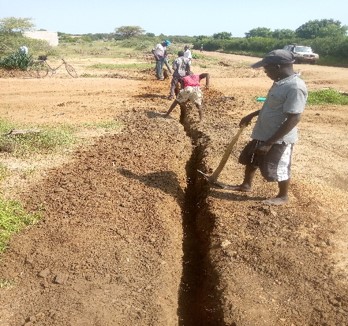
It was also noticed that one solar panel was missing which affected the system. This solar panel is added and tightened to secure it so wind won’t disturb it.

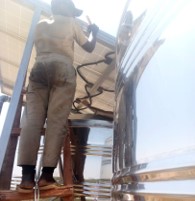
As seen in the picture below, the system is now providing clean water with enough pressure.
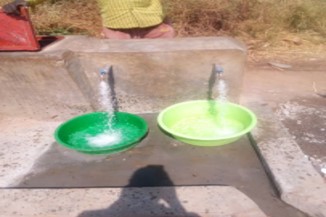
Key Lessons Learnt
- The design data for solar system is supposed to be real time data not based on assumptions, otherwise you end up with a lot of errors.
- Lack of contractors with good technical skills in solar pumping is a challenge and affects the project implementation process.
- There is need for tight technical supervision on the contractor that we have chosen to ensure value for money. Otherwise, most of the contractors or service providers are profit oriented in their mind.
- You need to have community engagement and accountability (CEA), that is involving communities at all level as we are carrying out our project implementation, also at the design stage. Involvement of community & local water authority at all stages of the project leads to a successful project hence, sustainability due to clear O&M plans. If we do that, we will have a successful project. The sustainability aspect of it will be clear, because the communities were involved from the start.
- Timely training of water user committee for skill transfer and management fosters sustainability.
- Adequate project duration allows for proper planning & implementation. If you give a project a limited months say three months, you wanted it to be completed and yet it has to begin from feasibility study, design and begin implementation with a lot of community engagement then you will realize three months will not be enough. So, if you give yourself adequate project duration you will likely achieve a good result.
